
Smithora naiadum
Seagrass Laver, Red Fringe
Interactions conducted: 14 June 2021, (start time 10:40am PDT)
Fishboat Bay, Juan de Fuca Strait, BC.
Tide: 1.0 foot tide 11:30am PDT (measured at Sheringham Point Tidal Station)
Conditions: Mostly clear (5% cloud cover), no precipitation, wind variable 10 – 15 km/hr, sea rippled, 15˚C.
Phase of Moon: Waxing Cresecent (approx. 103 hours into this phase at time of interaction); (Previous Phase, New Moon, 10 June 2021 at 3:52am PDT: Next Phase, First Quarter, 17 June 2021 at 8:54pm PDT.)
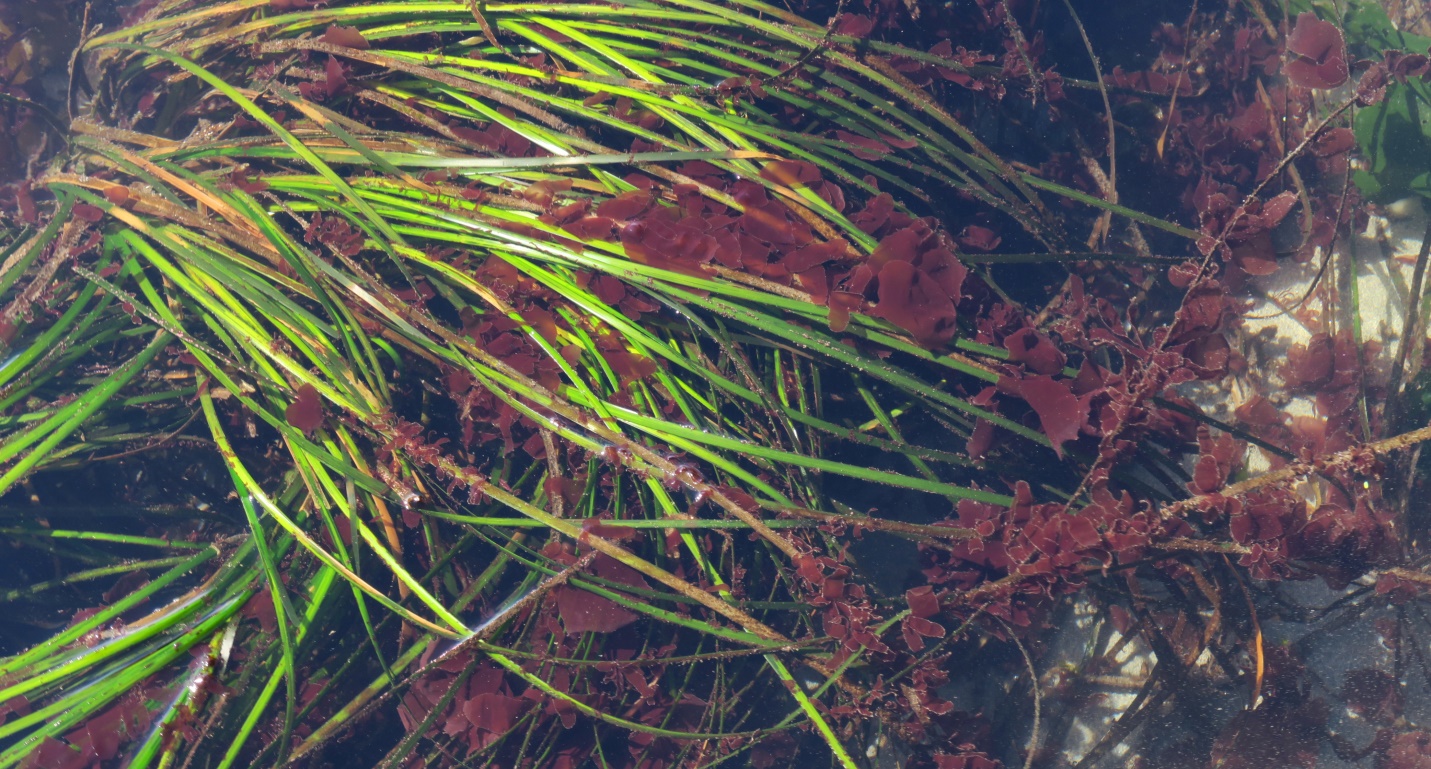
Figure 1: The bright green stems of seagrass immersed here in the low intertidal zone are hosting a showy growth of the epiphytic red alga, Smithora naiadum. Fishboat Bay, Strait of Juan de Fuca, B.C., Canada. June 14, 2021. Photo ID 27381 ©Seaweedwhisperings.com
Person 1:
Thin, frilly blades of random sizes, attached to seagrass blades.
Dark red coloration.
When pulled from water collapses into slippery, slimy mass.
When put back into water, immediately bounces back and shows its delicate beauty.
Very happy and buoyant in water.
Unhappy when out of its element, shrinks into the background.
Although it seems to cover and perhaps impede the growth of the seagrass it’s not malevolent.
Some of it is close to the bottom, others up high; they were at all different levels in the water – just experimenting with life? Where to best thrive/fit in?
Pleasantly edible to taste. Actually delicious, a bit sweet. Somewhat crisp, but delicate texture. I wanted to eat some more. I could have a whole salad of this!
Graceful to watch as it flaps and meanders as its seagrass host waves in the water.
Constrained somewhat by its host – wants to explore more, and can’t do what it wants independent of the host.
We interacted with this seaweed by standing in 10-20 centimeters of water; it would have been very difficult to get a sense of Smithora if we’d only seen it out of water.
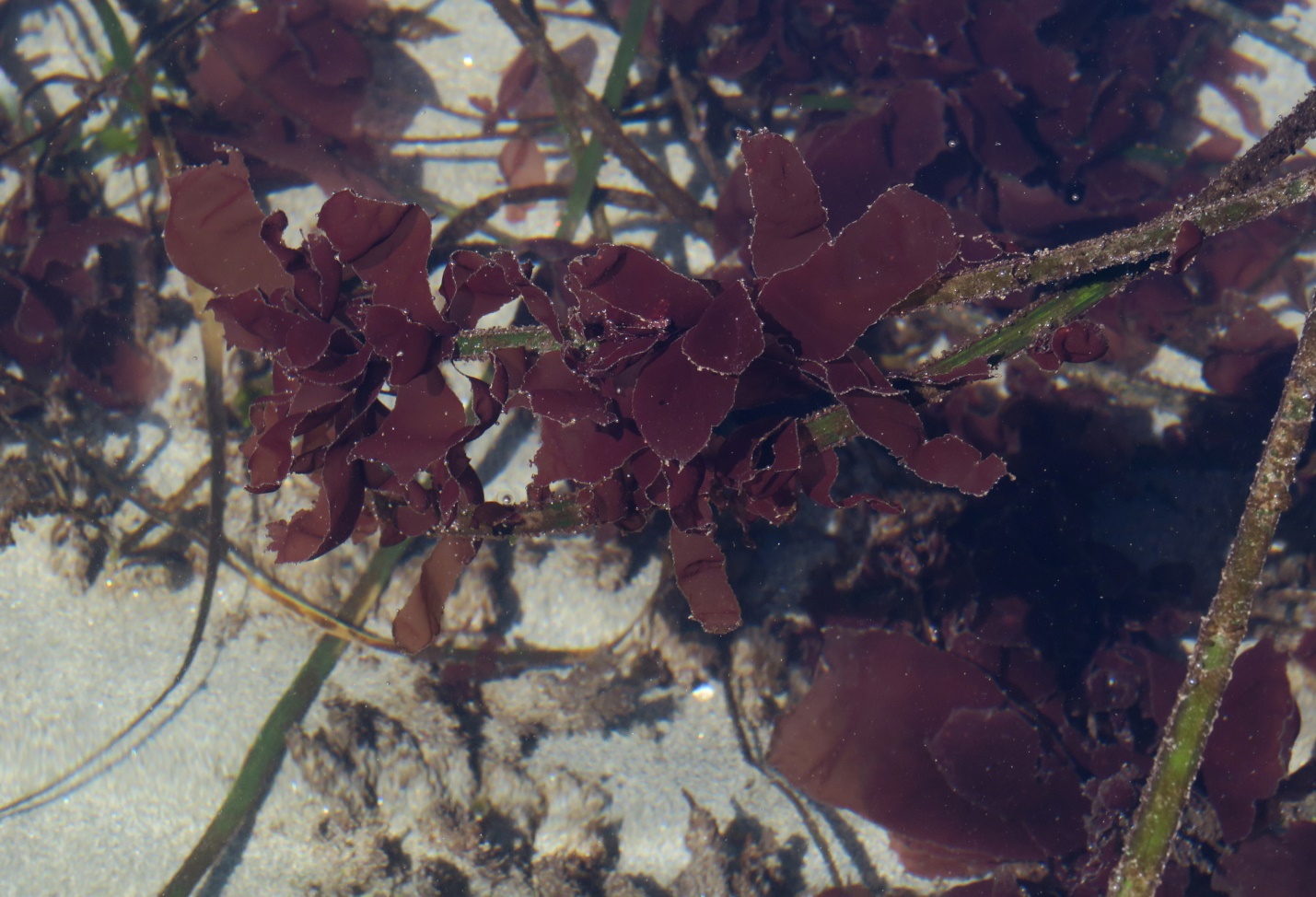
Figure 2: A closer view of the purplish-red blades of this laver shows some of the variety of sizes and shapes manifest. Blades are only one cell thick, and grow newly each spring from their cushiony holdfast which persists year-round on the seagrass host. Fishboat Bay, Strait of Juan de Fuca, B.C., Canada. June 14, 2021. Photo ID 27382 ©Seaweedwhisperings.com
Person 2:
Deep brownish red “petals” strung along the seagrass blades.
Some round, some oval, many sizes.
Tinged here today with tiny white dots at edges.
You ride in the waves as the seagrass pulls you and you also add your own movements – waves, flutters, and flourishes too. A single word to describe this action is not one I can find.
Some blades are tiny 0.5 cm x .25 cm and some are much larger 7 cm x 4.5 cm.
You grow, and seemingly multiply, along the seagrass stems.
Your proliferation works for you.
What about for the seagrass?
I think the seagrass feels rather overtaken by you, crowded out by your enthusiastic growth. You don’t seem to notice this though. You’re busy being and growing and dancing with your swishing red ‘skirts’. Here today you are thriving.
Blades tug off easily when I pull.
Tasted two – no taste and no texture, limp sheet of alga – eaten fresh like this, there was not much pleasure.
Watching you move, however, is entrancing, potentially even mesmerizing. Part of this is you swinging and wafting and rippling your skirts around, Smithora, and part of it is “your ride” – the graceful and more steady movements of the long strands of seagrass.
I see some of you that are “ghosts” – not red at all, just a transparent sheet with no color; why did you die and bleach out when your next door relatives are healthy, deep red and still wafting in the waves? What happened that you lost your color?
I went back to taste this seaweed again after Person 1 exclaimed his delight in it. My second experience was an initial taste of salt then soon a fuller, richer taste that is unique. The taste reminds me of gentle Japanese seafood flavors and of nori – but better. Fresh and delicious.
It is curious that my initial taste assessment was bland. Does this vary? Or did I need to eat a certain quantity to have my senses register this?
Does quantity matter? You certainly are a seaweed that I’ve only seen in great numbers. If you are present, you are numerous.
You, Red Fringe, also pull off the seagrass in groupings, at least in pairs. This is especially true with the “bigger” blades (4 cm x 2.5 cm); the smaller blades can more often pull off singly.
Do you “pair up” or “group up” and strengthen as you mature?
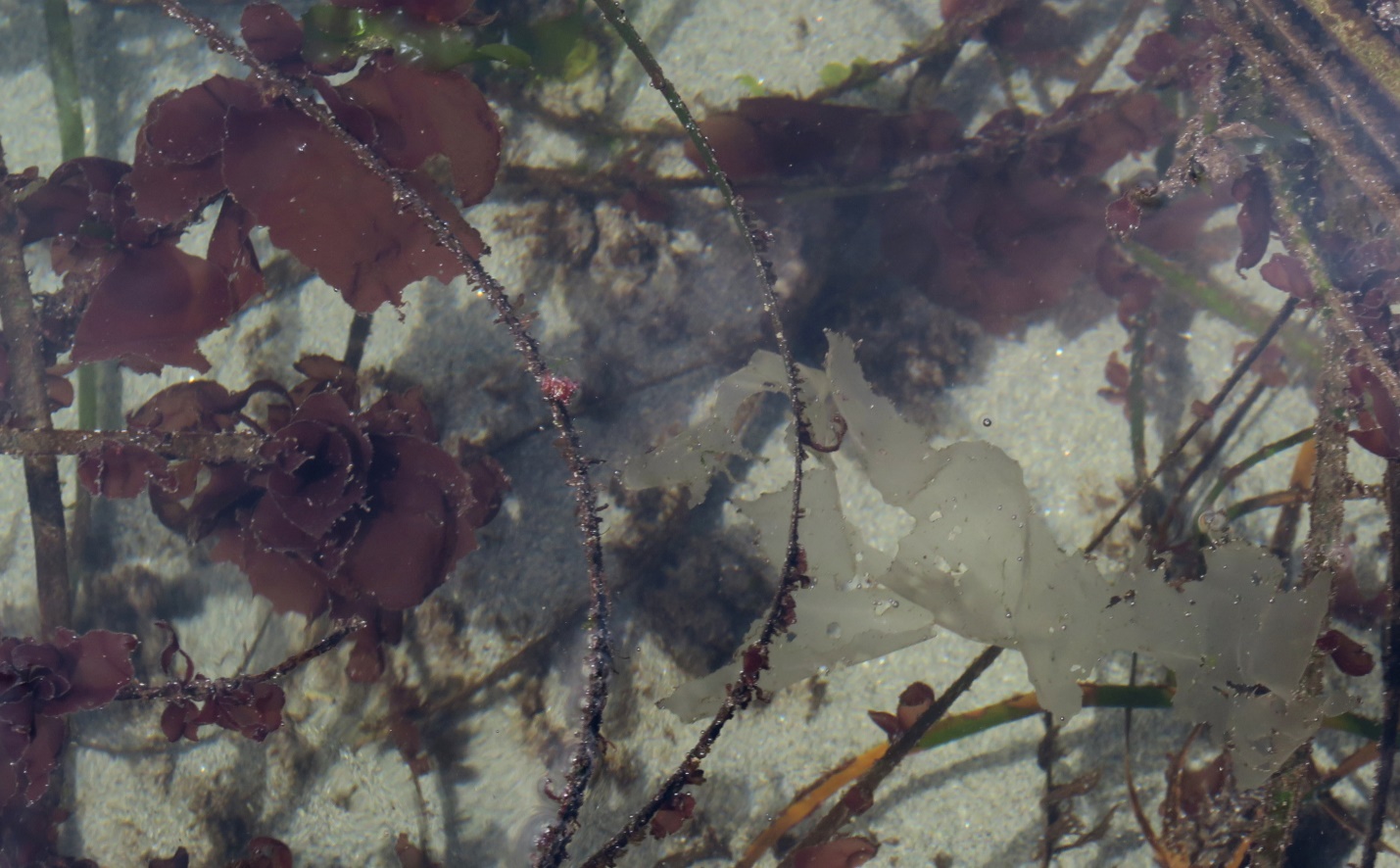
Figure 3: The lower right quadrant of this photo shows a few of the “ghost-like” blades of Smithora. Presumably these thalli have died, and along with the end of their photosynthesis processes, they have been bleached of all color. Fishboat Bay, Strait of Juan de Fuca, B.C., Canada. June 14, 2021. Photo ID 27383 ©Seaweedwhisperings.com
Discussion:
No taste with one bite, then delicious full taste at another.
Dark purplish red, then some are clear – absent of all color.
Collapses out of water to a slimy mess, but immediately ‘bounces back’ to graceful dancing form when immersed in water.
There are some real extremes / polarities we experienced with Smithora naiadum…
Another extreme with Smithora is how profuse the growth can be on the seagrass host. By full summer it could seem that so much Red Fringe has grown that this may be harmful to the seagrass’s own life cycle. The seagrass can appear to be almost obliterated from view and therefore deprived of sunlight by all the red algae growing along its slender blades. Imbalance might be one interpretation of this scenario, however there is seasonality at work here, for both grass and algae. The seagrass multiplies both by rhizomatic growth and it also ‘flowers’ earlier in the season, early enough that there is a successful growth cycle. And then, well, then the Red Fringe progresses on to its seasonal maturity, flourishing in what can look like excess, before completely dying back to the holdfasts for the winter. One will never observe Smithora naiadum without also observing seagrass and it seems that the two life forms have found a shared life cycle that may not be competitive at all but which is actually complementary and compatible.
However delicate and ‘nymph’-like the individual red blades may look, it seems that Smithora also can be misunderstood or possibly misjudged. Red Fringe certainly can look obvious, overabundant and dramatic in its profusion, and by so doing, this can prevent the observation of something else that is also self-evident but not dramatic – that being the deeper accord that has been reached.
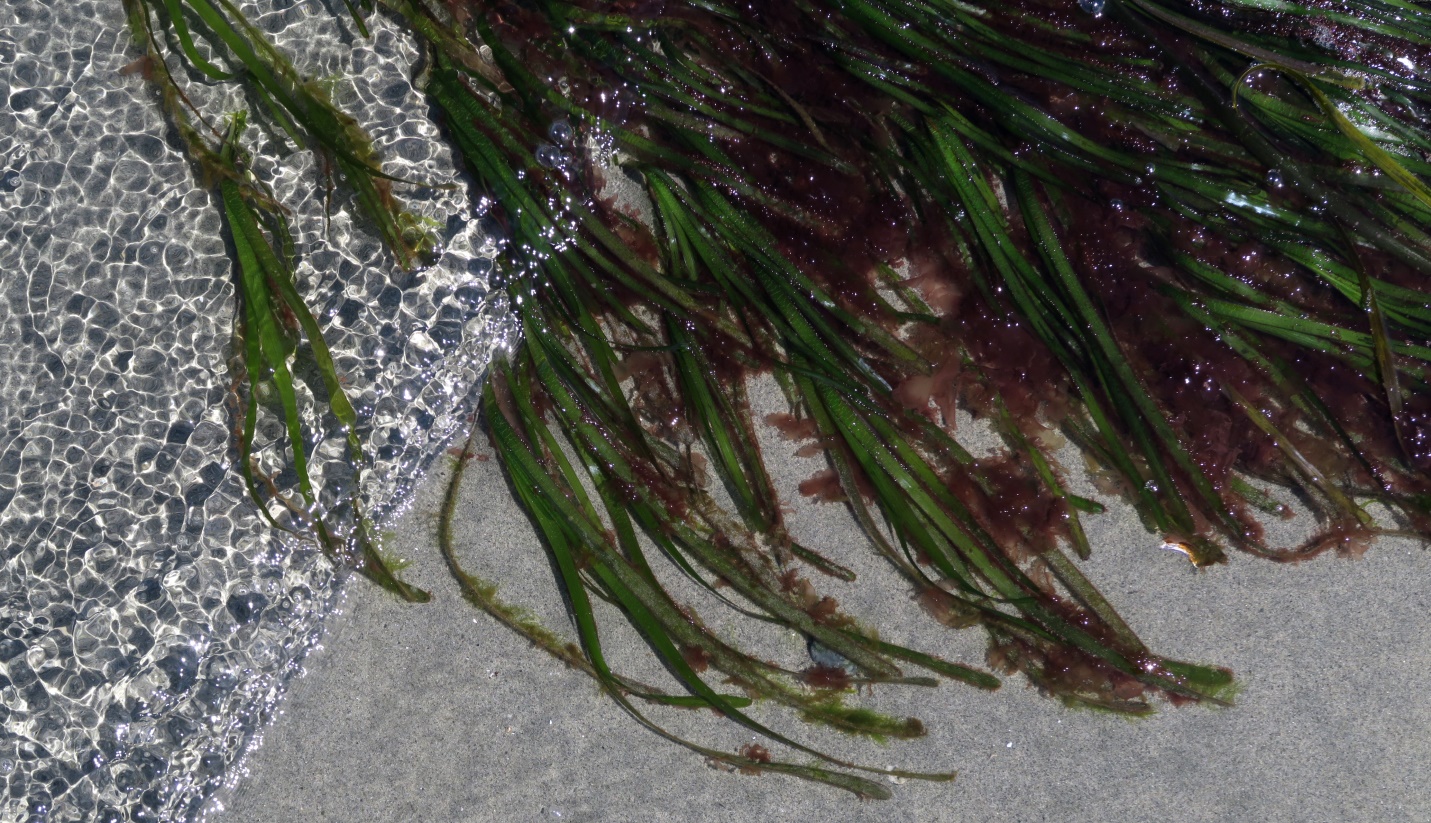
Figure 4: A gentle ocean swell washes over a clump of seagrass that is richly ‘fringed’ with Seagrass Laver. Little Qualicum River Estuary, Strait of Georgia, B.C., Canada. July 5, 2020. Photo ID 27384 ©Seaweedwhisperings.com
Biology & Natural History Information:
Description:
Thalli are small, thin, roundish to wedge-shaped elongate, purplish-red to pinkish-brown blades that grow to 5 cm tall. Multiple blades, up to 30, arise via short stalks from a cushion like base (holdfast) along the margins of seagrass blades. Red Fringe is easily found in the summer and early fall when it has reached its fullest growth; at this season this red alga often forms a dramatic edging to the seagrasses. Only one cell thick, the blades never lose their delicate, translucent nature. The cushiony holdfasts of Seagrass Laver persist year-round with new blades arising in the spring and dying back in the fall.
Habitat:
This species is epiphytic on seagrasses in the low intertidal and upper subtidal.
North Pacific Distribution:
Alaska Peninsula, Alaska to Baja California, Mexico.
Remarks: Smithora naiadum is the type species (holotype) of the genus Smithora. A similar laver species, Pyropia gardneri, is epiphytic also but it grows on Laminaria kelp blades; Smithora grows exclusively on the blades of Phyllospadix spp. and Zostera marina seagrasses. The genus is named for Gilbert Morgan Smith, a famous botanist and phycologist form Stanford University. The species name is derived from the Latin for ‘water nymph’. Smithora and Porphyra red algae are visually difficult to distinguish; with Smithora there is a cushiony discoid holdfast, whereas Porphyra attaches by rhizoidal cells.
Former name(s): Porphyra naiadum C.L.Anderson 1892, Membranella nitens Hollenberg & I.A.Abbott 1968
Classification:
Phylum: Rhodophyta
Class: Compsopogonophyceae
Order: Erythropeltidales
Family: Erythrotrichiaceae
Genus: Smithora
Species: Smithora naiadum (C.L.Anderson) Hollenberg 1959
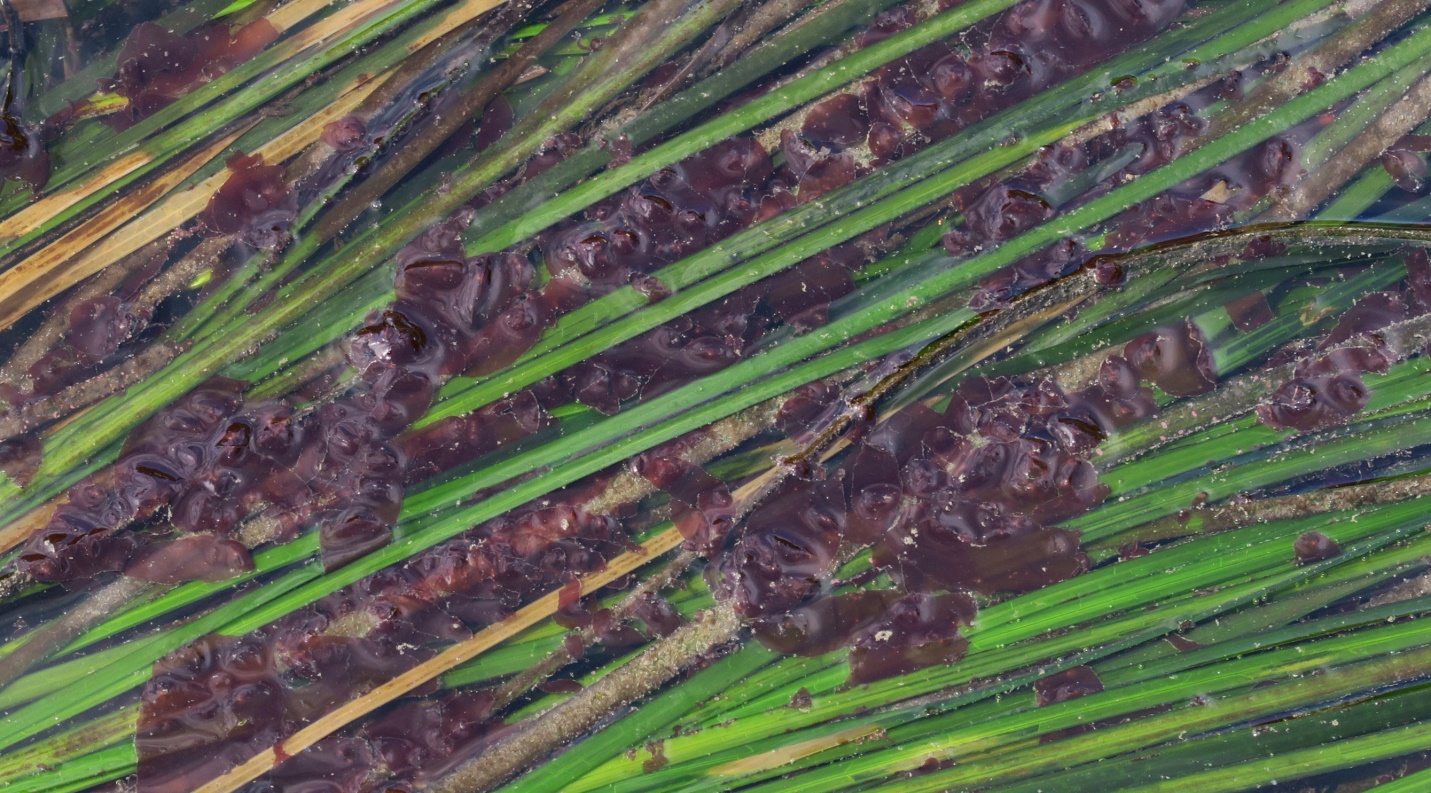
Figure 5: Rafted up atop their seagrass host, many blades of Smithora naiadum are ‘stilled’ by the temporary absence of water movement. Fishboat Bay, Strait of Juan de Fuca, B.C., Canada. June 14, 2021. Photo ID 27385 ©Seaweedwhisperings.com
![]()